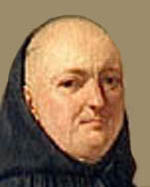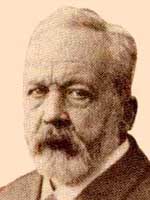Seeing History
PhilologyIt is not correct to define history as that which is learned from documents, but documents do play a major role. If the period and culture one studies are not one's own, the first task is to learn the language of the documents, and the usages of the times. But we cannot simply use those skills to skim history off a document; the document itself must be scrutinized. This was implied, in the case of Sallust, on the previous page. We take it up here for further attention, and the small details to larger vistas.
A Story
For a start: Do we actually have the text of a passage, or is there a scribal error which introduces a misunderstanding?



. . .



An apocryphal story [LSCC 22F3] tells how Dz-syà, the disciple of Confucius, read in the archives of Wei that the host of Jin "crossed the River with three pigs" [the lefthand phrase above]. This he ventured to doubt, since it is gibberish. What was the correct reading? He conjectured the look-alike phrase "crossed the River on [the cyclical day] ji/hai" [the righthand phrase]. And he later verified, in the archives of Jin, that this was the correct reading. The story dates from about 0220. It is completely invented; it never could have happened. What it shows is that, as of c0220, the principle of conjectural emendation later confirmed by the discovery of a document; the sort of thing that Bentley was later to be famous for, was already understood. Here is ideal of the philologist as visionary, penetrating the clouds of the present, and seeing straight back to the undistorted past. Dz-sya (in the early 05th century) never did it, but somebody who contributed to the second layer of the LSCC text (in the late 03rd century) understood it.
We too should understand it. Of such kind are the errors that one scribe can make. It follows that if a document reaches us by transmission from copyist to copyist, each copyist being liable to make these and other errors, the distortion of the text is likely to be multiplied, and error detection becomes that much more urgent. The manuscripts of a text may be organized into families, each family being defined by deriving from a copy in which a certain error was first made, to be perpetuated thereafter. The texts at the head of each family may also be examined to see what relationships they may show to each other, all with the idea of constructing a stemma, a tree diagram, showing how each text branched off from the original, and suggesting where the line of least corruption may lie. At the end of that line, there waits us, if not the "author's manuscript," at any rate the earliest copy which the study of later copies can reveal to us. It is better called the archetype. By any name, it is the best we can get with what we have.
Those who have considered the doing of history in a rational way have given full credit to these preparatory labors of philology, as an analysis of the table of contents of Langlois et Seignobos or that of John Martin Vincent will instantly show. They have even defended the labors of the philologist against the scorn of those who grudge the time those labors take, the learning they presume, and the small scale (one word, one letter, one Masoretic vowel point) on which they sometimes operate:
There is only one argument for the legitimacy and honorable character of the obscure labors of erudition, but it is a decisive argument: it rests on their indispensability. No erudition, no history. (Introduction 112)
Or (Langlois et Seignobos go on to add), as Saint Jerome put it,
Non sunt contemnenda quasi parva, sine quibus magna constare non possunt.
Marc Bloch, writing half a century later and under the the Nazi occupation of France, pointed to the clarification of the value of the sources which only philology can provide:
True progress began on the day when, as Volney put it, doubt became an "examiner," or in other words, when there had gradually been worked out objective rules which permitted the separation of truth from falsehood. The Jesuit Papebroeck, in whom the reading of the Lives of the Saints had instilled a profound mistrust of the entire heritage of the early Middle Ages, considered all Merovingian charters which had been preserved in the monasteries to be forgeries. No, replied Mabillon. There are unquestionably some charters which have been retouched, some which have been interpolated, and some which have been forged in their entirety. There are also some which are authentic, and this is how it is possible to distinguish the bad from the good. That year, 1681, the year of the publication of the De Re Diplomatica, was truly a great one in the history of the human mind, for the criticism of the documents of archives was definitely established.
Not every historian needs to be a master of Greek paleography, or of Masoretic vowel pointing. But historians should know enough about it to tell whether the experts to whom they are delegating that task, the pourers of the foundation on which they propose to erect their castle of interpretation, have done their work well. And they should know who to ask if they think they find a problem in what they are trying to do.
The Aetiology of the Text
An error thus has its own microhistory. So does the text in which the error occurs. We can thus ask, of the error-corrected text: Do we really have the work of this philosopher, or are we reading a spurious chapter by some later follower? Philology deals with this large scale also: the authenticity, or the internal consistency, of whole texts.
Julius Wellhausen noticed that the books of Samuel contained, not one story of the founding of Kingship in Israel, but two stories. One was relatively neutral, and the other was distinctly hostile. The two were closely interwound throughout the text. By separating them, and noting their affinities, Wellhausen was able to clarify not only the earliest recorded tradition about the Kingship, but also the nature of a later revisionist critique of Kingship. Nor did he stop with Samuel. Beginning with a monograph on Samuel in 1871, Wellhausen by 1882 had reached the point where he could write a Prolegomena to the whole History of Israel.
The idea that texts are not necessarily all of a piece, but may have been built up in stages, over time, and contain material of different age and thus of different evidential value, is beautifully illustrated in the work of Wellhausen. Others have shown, in a similar way, how different prophetic traditions are combined in the Book of Isaiah. At the other end of the world, the accretional model of text formation is currently transforming our understanding of the entire classical period of China, by unraveling interwound narratives.
There have been recent attempts, some of them from within History, to get rid of Philology. But Philology, though undoubtedly an ancillary science, grades imperceptibly into History proper, the way your arm blends into your shoulder. It would be a mistake to try to amputate the one from the other. Where exactly would you stop?
Readings
- Bruce M Metzger. The Text of the New Testament. 3ed 1992. Useful examples of philology in action. The cardinal rule for evaluating variants, due ultimately to Tischendorf, is at p207
- E Bruce Brooks. The Present State and Future Prospects of Pre-Hàn Textual Studies. Announces the accretional model of text formation, and gives brief examples of its application
- E Bruce Brooks and A Taeko Brooks. The Original Analects. Applies the accretional model to the sayings attributed to Confucius, resulting in the recovery of the successive positions assumed by the Confucian School of Lu over the course of 230 years
- Julius Wellhausen. Prolegomena to the History of Israel (1882, 5ed 1899; tr 1957)
17 Dec 2006 / Contact The Project / Exit to Outline Index Page

